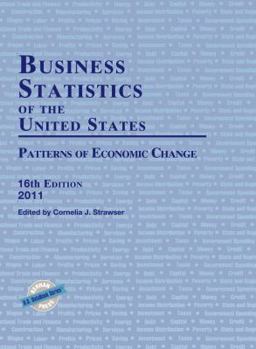Business Statistics of the United States 2011: Patterns of Economic Change
Business Statistics of the United States: Patterns of Economic Change is a comprehensive and practical collection of data that reflects the nation's economic performance since 1929. It provides over 80 years of annual data in regional, demographic, and industrial detail for key indicators such as: gross domestic product, personal income, spending, saving, employment, unemployment, the capital stock, and more.
A major reorganization in this edition of Business Statistics of the United States brings together in one place all historical data back to the year 1929 for each of the major U.S. economic indicators, instead of showing recent data in one chapter and historical background in another. More than ever, Business Statistics is the best place to find historical perspectives on the U.S. economy. Of equal importance to the data are the introductory highlights, extensive notes, and figures for each chapter that help users to understand the data, use them appropriately, and, if desired, seek additional information from the sources agencies. Business Statistics of the United States provides a rich and deep picture of the American economy and contains approximately 3,500 time series in all. The data are predominately from federal government sources including:Board of Governors of The Federal Reserve SystemBureau of Economic AnalysisBureau of Labor StatisticsCensus BureauEmployment and Training AdministrationEnergy Information AdministrationFederal Housing Finance AgencyU.S. Department of the Treasury
New to this Edition:
More historical data have been added.The monthly index of industrial production is shown all the way back to 1919, and monthly indexes of consumer and producer prices back to 1913. In both cases, these are the earliest dates for which the originating agencies (respectively, the Federal Reserve Board and the Bureau of Labor Statistics) have compiled a continuous series.Additional data for those who would like to compare inflation rates among major industrial countries have been included. A new table includes "Harmonized Indexes of Consumer Prices" for the United States, the European Union, the Euro area, 12 European nations, and Japan, all converted to the same conceptual basis--representing both urban and rural households and excluding owner-occupied housing.Annual data from the Bureau of Labor Statistics on hours worked per person, from the Current Population Survey (CPS), going back as far as 1948 have been added. These differ rather dramatically from the well-known "average workweek" statistics from the Current Employment Statistics survey (CES) that are reported monthly and have always been included in Business Statistics.In the lead article, "Business Statistics in Recession and Recovery," which compares the current recession-recovery period with earlier business cycles, has been extended through April 2011. In addition, there is a detailed comparison of economic characteristics of the last three completed peak-to-peak business cycle periods.Some interesting facts found inside Business Statistics:
In 2010, the median unemployed worker had been out of work 21.4 weeks--double the median length of unemployment in 1983 or 2003.By March 2011, there were 2.6 million more employed than at the December 2009 low. The employment/population ratio moved up from a low of 58.2 percent in November 2010 to 58.5 percent in March 2011.The value of imports from China, which grew by an average 23 percent per year from 2001 to 2006, slowed to a 6 percent increase between 2006 and 2010.The housing sector was the source of the boom and bust cycle of 2001-2009. In 2005, 2.1 million housing units were started, the highest since 1972. Of those, 1.7 million were one-family homes, an all-time record. By 2009, both total and single-family starts had plunged to the lowest levels of their 50-year history, and activity in 2010 was only slightly higher.Sales of cars and light trucks were 10.4 million in 2009, down 39 percent from their recent high in 2005; they recovered 11 percent in 2010.From 2007 to 2010, the deficit rose from 1.7 percent of GDP to 9.1 percent, an increase of 7.4 percentage points. Contributing to this were a 2.7 percentage point drop in tax receipts, an 0.7 percent increase in defense program spending, an 0.6 percentage point increase in non-defense program spending, and a 2.9 percentage point rise in social benefits to persons such as Social Security and unemployment insurance.Total federal government current expenditures increased from 17.6 percent of gross domestic product (GDP) in 1953--the peak for Korean War spending-- to 25.4 percent of GDP in 2010.Household spending on health in 2009 made up 20.3 percent of all household consumption spending--four and one/half times the percentage in 1948. This includes medical care payments made by government and private insurance on behalf of individuals as well as out-of-pocket consumer payments.
Format:Hardcover
Language:English
ISBN:1598884867
ISBN13:9781598884869
Release Date:October 2011
Publisher:Bernan Press
Length:650 Pages
Weight:4.04 lbs.
Dimensions:11.6" x 1.6" x 8.9"
Age Range:17 years and up
Grade Range:Grade 12 to Postsecondary
Customer Reviews
0 rating





